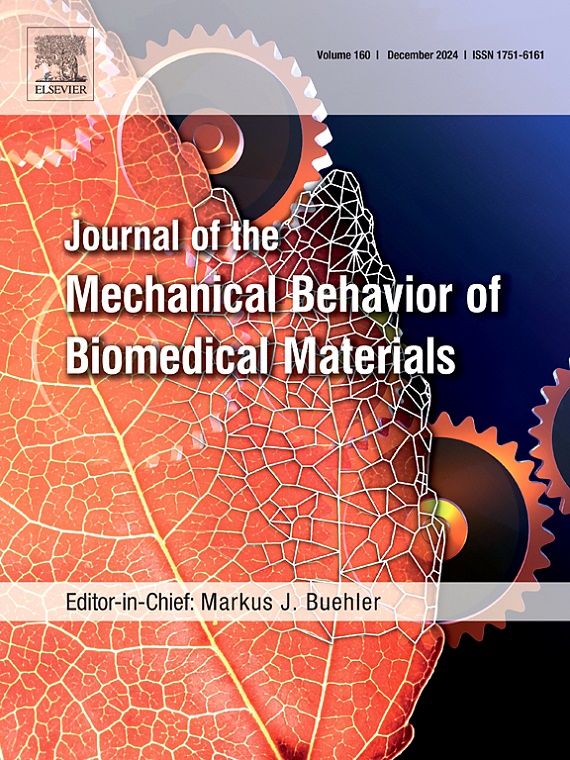Anisotropic ice-templated collagen scaffolds for soft tissue engineering: a mechanical characterisation toolkit
IF 3.3
2区 医学
Q2 ENGINEERING, BIOMEDICAL
Journal of the Mechanical Behavior of Biomedical Materials
Pub Date : 2025-07-03
DOI:10.1016/j.jmbbm.2025.107121
引用次数: 0
Abstract
Collagen-based soft tissues are often anisotropic in structure, and in regenerative medicine, it is important that scaffolds are designed to closely mimic their architecture and mechanical behaviour. Existing testing standards are not directly applicable to anisotropic structures in physiologically relevant conditions. The challenge is therefore to systematically quantify mechanical anisotropy, nonlinear tensile behaviour, and both in vitro degradation and fatigue in a way appropriate for soft, porous, natural macromolecular structures. In this study, we fabricated collagen scaffolds with elongated porosity via directional freeze-drying and then chemically crosslinked them using 1-ethyl-3-(3-dimethylaminopropyl) carbodiimide hydrochloride (EDC) and N-hydroxysuccinimide (NHS). Compressive mechanical behaviour was monitored along two characteristic directions, and distinct stress-strain curves were observed. The elastic modulus was identified as 6.42 kPa and 1.02 kPa along the two directions. Nonlinear tensile behaviour was characterised using the tangent modulus, which varied from 25 kPa to 270 kPa before failure. Standardised methods for monitoring degradation at 37 were developed. In vitro degradation was investigated by immersing scaffolds in deionised water for 60 days, during which the critical stress decreased by 30% in the first 30 days. Fatigue was studied by monitoring the stress-strain curves under 20% tensile strain for 1000 cycles. Scaffolds exhibited weaker mechanical integrity when loaded at 1.43 Hz. This study addresses the lack of standardised testing methods for anisotropic ice-templated collagen scaffolds by establishing a set of protocols to characterise the mechanical anisotropy, quantify tensile behaviour, and monitor scaffold degradation. This flexible characterisation toolkit can be adapted to specific sample treatments during tissue culture.

用于软组织工程的各向异性冰模板胶原蛋白支架:力学表征工具包
基于胶原蛋白的软组织在结构上通常是各向异性的,在再生医学中,重要的是支架的设计要密切模仿它们的结构和力学行为。现有的测试标准不能直接适用于生理相关条件下的各向异性结构。因此,挑战在于系统地量化力学各向异性、非线性拉伸行为、体外降解和疲劳,以适合于柔软、多孔、天然大分子结构的方式。在本研究中,我们通过定向冷冻干燥制备了具有细长孔隙度的胶原蛋白支架,然后用1-乙基-3-(3-二甲氨基丙基)盐酸碳二亚胺(EDC)和n -羟基琥珀酰亚胺(NHS)进行化学交联。沿着两个特征方向监测压缩力学行为,观察到明显的应力-应变曲线。沿两个方向的弹性模量分别为6.42 kPa和1.02 kPa。非线性拉伸行为是用切模量来表征的,在失效前切模量从25 kPa到270 kPa不等。开发了37°C下监测降解的标准化方法。通过将支架浸泡在去离子水中60天来研究其体外降解,在此期间,前30天的临界应力降低了30%。通过监测20%拉伸应变下1000次循环的应力-应变曲线,对其进行了疲劳研究。1.43 Hz加载时,支架的力学完整性较弱。本研究通过建立一套描述力学各向异性、量化拉伸行为和监测支架降解的方案,解决了各向异性冰模板胶原支架缺乏标准化测试方法的问题。这种灵活的表征工具包可以适应于组织培养过程中的特定样品处理。
本文章由计算机程序翻译,如有差异,请以英文原文为准。
求助全文
约1分钟内获得全文
求助全文
来源期刊

Journal of the Mechanical Behavior of Biomedical Materials
工程技术-材料科学:生物材料
CiteScore
7.20
自引率
7.70%
发文量
505
审稿时长
46 days
期刊介绍:
The Journal of the Mechanical Behavior of Biomedical Materials is concerned with the mechanical deformation, damage and failure under applied forces, of biological material (at the tissue, cellular and molecular levels) and of biomaterials, i.e. those materials which are designed to mimic or replace biological materials.
The primary focus of the journal is the synthesis of materials science, biology, and medical and dental science. Reports of fundamental scientific investigations are welcome, as are articles concerned with the practical application of materials in medical devices. Both experimental and theoretical work is of interest; theoretical papers will normally include comparison of predictions with experimental data, though we recognize that this may not always be appropriate. The journal also publishes technical notes concerned with emerging experimental or theoretical techniques, letters to the editor and, by invitation, review articles and papers describing existing techniques for the benefit of an interdisciplinary readership.
 求助内容:
求助内容: 应助结果提醒方式:
应助结果提醒方式:


